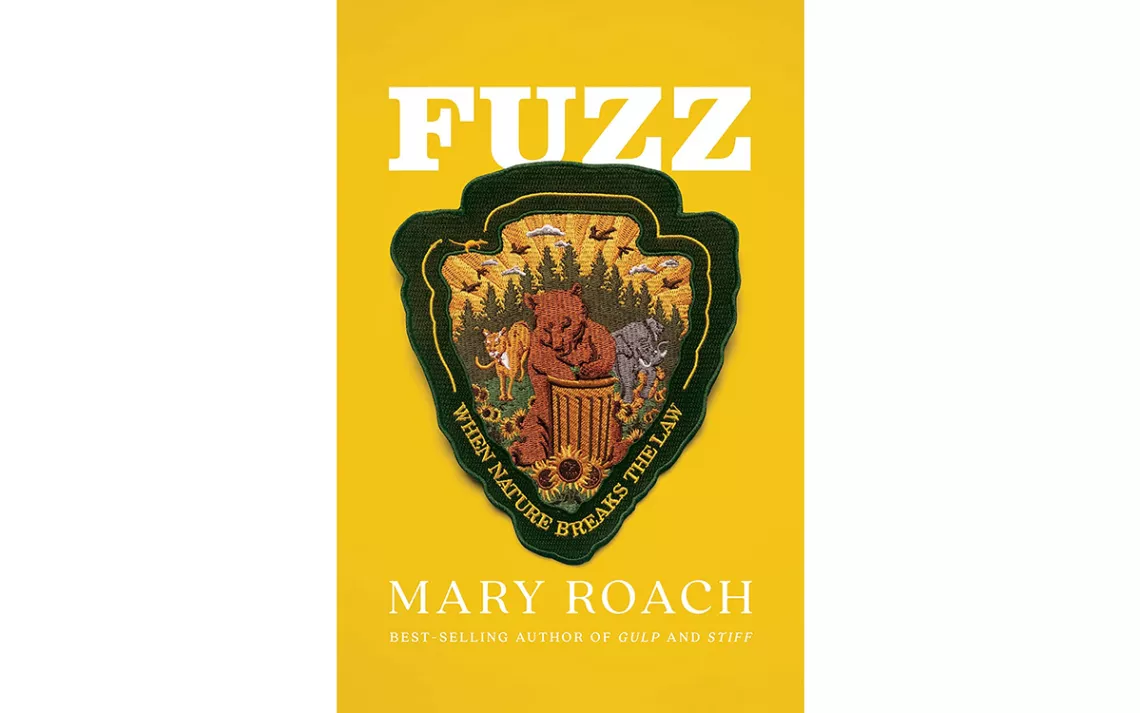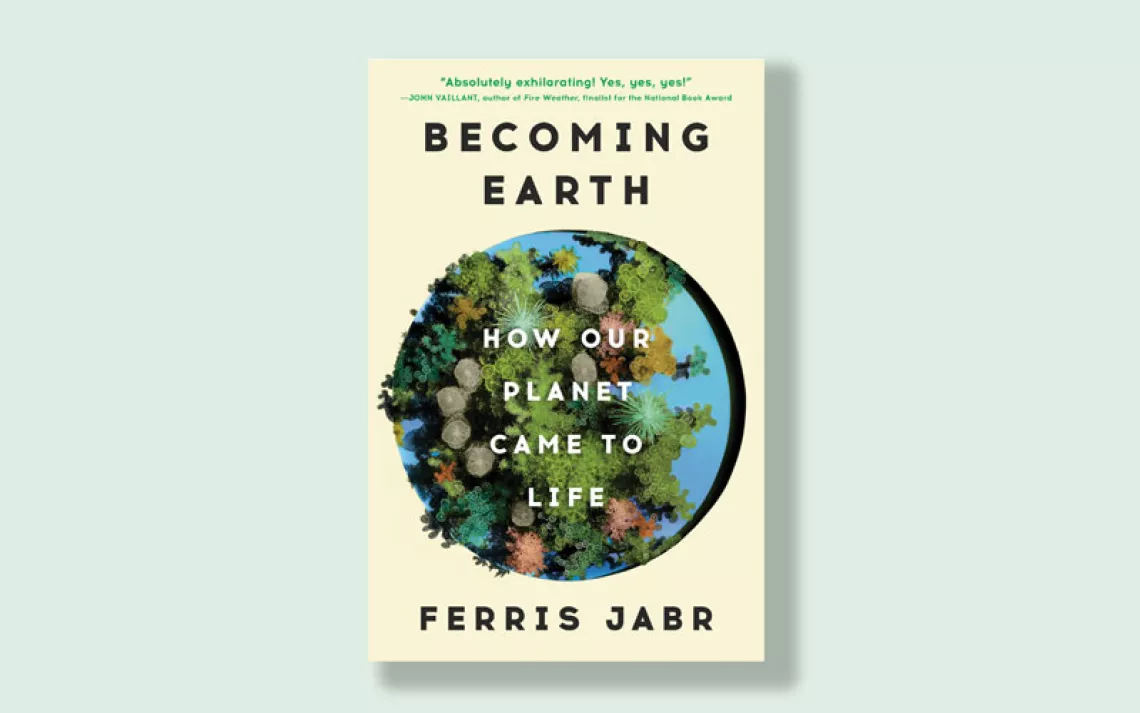Can’t We All Just Get Along?
Mary Roach’s new book, Fuzz, explores the management of human-wildlife conflicts

Grizzly 1048M first ran afoul of the law in July. The bear, a young male, was busted for eating horse feed on a Wyoming ranch. State biologists captured him, relocated him, and prayed he’d stay out of trouble. By August, though, 1048M was back: cracking open garbage cans, breaking into chicken coops, and gnawing on rubber rafts. Plastic laced his scat. Biologists apprehended 1048 again, and this time they killed him. Yet 1048 wasn’t a criminal—he was a victim. “All of the behaviors that bear was displaying,” declared one official, “are a direct result of him being able to access human food sources.”
1048’s plight is, alas, an increasingly common one. More grizzlies have already died at human hands this year than during all of 2020. And bear clashes are just one manifestation of a broader crisis: the growing global prevalence of human-wildlife conflict. In Tanzania, 60 people and 150 lions perish annually in run-ins between our two species; in North America, deer-vehicle collisions kill 200 people and perhaps a million whitetails. “Two thousand species in two hundred countries regularly commit acts that put them at odds with humans,” the science writer Mary Roach reports in her new book, Fuzz: When Nature Breaks the Law.
Fuzz’s subject is the burgeoning field of wildlife conflict management, in its many bizarre forms. Roach introduces readers to the black bears breaking into tony Aspen homes and the biologists trying to instill bear-smart behavior in the town’s millionaire ski bunnies. She chronicles the gulls ripping up the Vatican’s daffodils and the guy who repels them with lasers. She visits the macaques that mug pedestrians in India and the abandoned mine where offending monkeys are interred. She tastes a novel rat bait and compares it to eating suntan lotion. (If anything, her curiosity is too broad: A chapter about poisonous beans feels like a non sequitur.)
Roach, whose previous books have explored topics including the fate of human cadavers and the wonders of the alimentary canal, has always reveled in the morbid; she’s surely Morticia Addams’s favorite science writer. Thus we learn about the blood spatter patterns produced by a bear attack, the precise physiological effects of possum poison, and the fact that a human skull, in the jaws of a carnivore, behaves like “a very ripe plum.” She adores quirky asides—geese don’t poop nearly as much as authorities would have you believe—and odd analogies. It’s one thing to state that mountain lion attacks are rare and another to note, as Roach does, that you’re as likely to be killed by a cougar as you are a filing cabinet.
We Homo sapiens, by contrast, are considerably deadlier than office furniture. Roach documents humanity’s historical sins with grim relish. In 1932, the Australian military dispatched troops to gun down emus accused of ravaging wheatfields. (The emus, claimed one officer, “face(d) machine guns with the invulnerability of tanks.”) A decade later, American sailors clubbed 80,000 albatrosses to death on Midway Atoll, for fear that the “gooney birds” would bring down aircraft. Such bloodbaths were neither evidence-based nor effective. The annual poisoning of a million blackbirds at the behest of the sunflower industry, Roach observes, “seemed almost more like spite than pest control, a practice undertaken out of frustration and anger, rather than documented results.”
The entity that kills all those blackbirds is Wildlife Services, the federal branch tasked with culling sheep-eating coyotes, culvert-clogging beavers, and other inconvenient critters—more than a million native animals in 2019 alone. For years, Roach reports, agency scientists have been developing sensible alternatives to poisons and traps. The problem is getting Wildlife Services’ squadron of field trappers to heed their own agency’s researchers. “Let’s just say the ship is slow to turn,” one Wildlife Services biologist tells Roach—rare candor from a notoriously tight-lipped bureaucracy. “But it is turning.” Well, maybe. If the ship is turning, it’s not yet reflected in the data: The agency reports killing some 62,000 coyotes in 2020, nearly a thousand more than it did the previous year.
What might a gentler approach look like? “Each conflict needs a resolution unique to the setting, the species, the stakes, the stakeholders,” Roach writes. Fuzz is filled with tricks of the trade: An animatronic falcon called the RoBird scares gulls off landfills. Indian dignitaries employ a monkey called the langur to chase away marauding macaques. (When Donald Trump visited the Taj Mahal, a langur was on his security detail.) A vulture effigy, hung by its feet in a parking lot, can prevent live turkey vultures from tearing off windshield wipers. It would probably keep the neighbors off your lawn too.
These tactics—One Weird Tip to Deter Vultures!—have their place. But I wish that Roach had also considered strategies for treating the roots of human-wildlife conflict, rather than just its symptoms. “Almost without exception, the wildlife in these pages are simply animals doing what animals do: feeding, shitting, setting up a home, defending themselves or their young,” she writes. “They just happen to be doing these things to, or on, a human, or a human’s home and crops.” But animals encroach upon our homes because we’ve razed theirs. The ultimate form of conflict mitigation would be protecting large, connected swaths of habitat through which critters could wander without bumping into humans and our infrastructure. This is the principle that undergirds proposals like 30x30, E.O. Wilson’s Half-Earth, and, indeed, modern conservation biology. Bear-proof dumpsters are good. A continental network of wildlife corridors would be better.
Roach might also have more fully explained the stakes of her chosen field. Left largely unmentioned is that our planet is suffering its sixth mass extinction and that wildlife conflict is among its leading causes. Every tiger shot for menacing farmers and every panther struck on a Florida highway brings us one casualty closer to losing species altogether. Large carnivores are both disproportionately susceptible to conflict and disproportionately vital to functional ecosystems. Conflict resolution doesn’t just promote the welfare of individual animals. It’s imperative for preserving the diversity of life on Earth.
While Fuzz is mostly concerned with the gee-whiz technology of wildlife conflict—robo-falcons, lasers, genetic engineering, and the like—cultural change might be even more important. In some of her most affecting chapters, Roach visits India, where testosterone-crazed bull elephants routinely stomp farmers. (More than a third of trampling victims are drunk; presumably you’d have to be to challenge an elephant.) Yet Indians largely tolerate these incidents, in part because Hindu deities often take the form of elephants and other animals. Even man-eating leopards get three strikes, and the rat that scurries across Roach’s foot is considered a blessing.
It’s heartening to remember that America’s lethal approach to conflict doesn’t stem from some immutably bloodthirsty aspect of human nature. Instead it’s a social construct that can yet be unlearned. In the face of a rampaging elephant, one tea farmer tells Roach, “We just say, ‘Namaste and go away.’”
 The Magazine of The Sierra Club
The Magazine of The Sierra Club



